Content
- The location of the nasopharynx in humans
- Anatomy and structure of the nasopharynx
- Openings (2 choanae and 2 nasal tube openings on the lateral walls)
- Tonsils
- Fabrics
- Functions
- Communication with nearby authorities
- What diseases can occur in the nasopharynx?
- Squamous cell carcinoma
- Inflammation of the walls of the nasopharynx
- Polyposis
- Atrophic rhinitis
- Signs of defeat
- How the nasopharynx is examined, diagnostic techniques
- Video about the structure of the nasopharynx
Human nasopharynx is a cavitywhich is part of the upper respiratory tract. This organ is directly involved in providing the body with a sufficient volume of air, protects against pathogenic microflora of the environment. Studying the structure of the nasopharynx in a sectional photo, one can find that this segment of the respiratory system smoothly passes into the pharynx, and its anatomical division is carried out by the tissues of the hard palate.
The location of the nasopharynx in humans
The nasopharynx (in the photo in the section, you can study in detail all the features of its structure) is an organ of the respiratory system located in the human skull, which connects the larynx and the oral cavity. It connects to the occipital and sphenoid bones of the skull, and its dorsal wall is in contact with the 1st and 2nd vertebrae of the cervical spine.
The human nasopharynx is positioned in such a way as to ensure maximum air throughput, inhaled through the nasal canals, warm it up to the optimal temperature before delivery to the bronchopulmonary the cloth. Inflammatory processes, congenital and acquired defects of this organ lead to disruption of the natural breathing process, the development of concomitant pathologies.
Anatomy and structure of the nasopharynx
The nasopharynx is characterized by a fairly simple anatomical structure, as well as the functional purpose of each of its elements. The compact arrangement of the organ, as well as a large amount of lymphoid tissue, indicates its importance in ensuring the safe life of the whole organism.
Openings (2 choanae and 2 nasal tube openings on the lateral walls)
Inside the nasopharynx of a person there are 2 nasal openings (choanas), which are designed to carry out the function of breathing through the nose. This part of the organ smoothly passes into the larynx. During normal physiological development, choanas have the same width.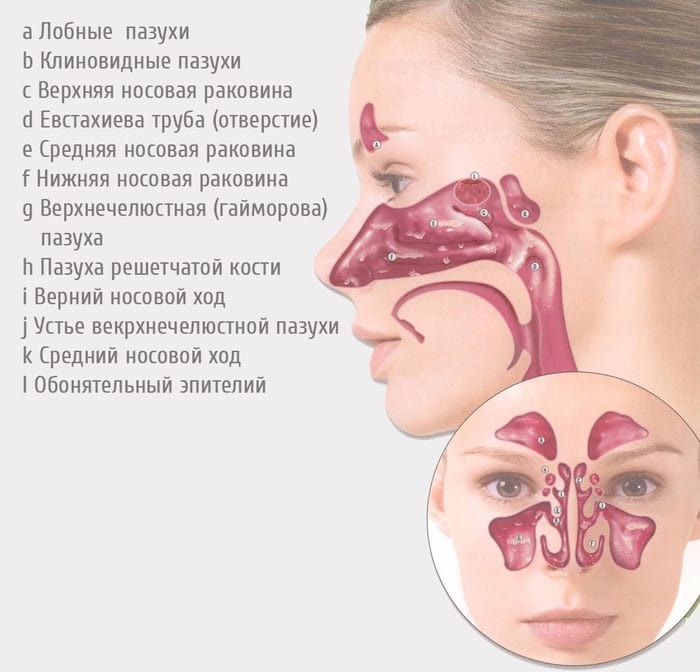
The airways of the nasopharynx are separated by a nasal septum, which consists of cartilaginous tissue. Congenital or acquired curvature of this part of the respiratory system leads to the fact that the nasal passages may not have the same width of the lumen.
Tonsils
On the lateral walls of the nasopharynx there are tubal tonsils, which are paired. On the surface of the back wall of this organ of the respiratory system, there is an unpaired tonsil (pharyngeal). Even in the structure of the nasopharynx, 2 palatine and 1 lingual tonsil are concentrated.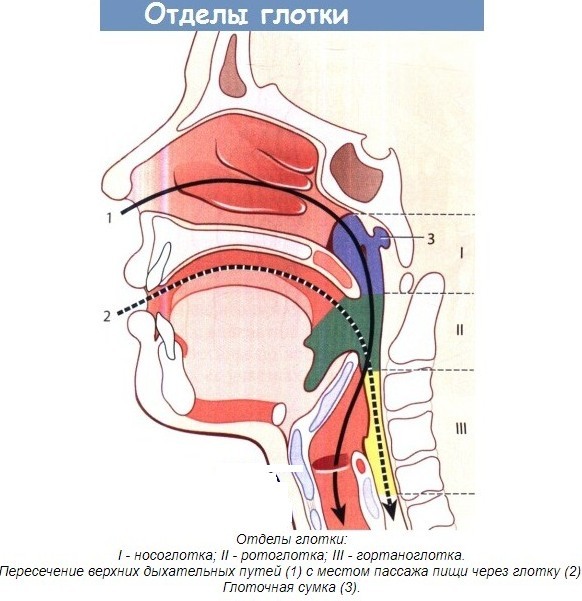
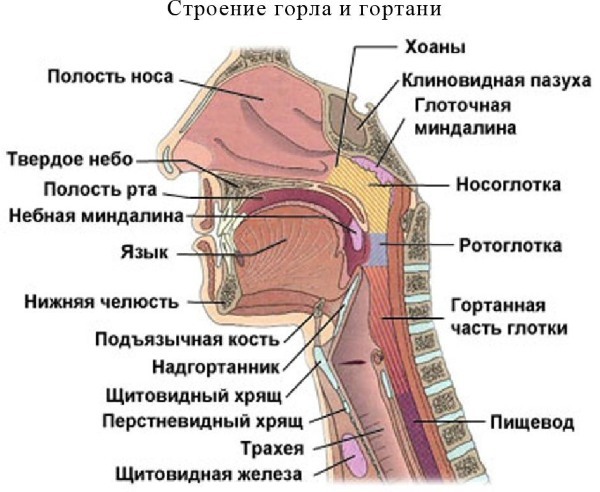
By their etiology, the tonsils are an accumulation of lymphoid tissue, which is necessary to protect the body from the penetration of pathogenic microorganisms. The most vulnerable and prone to frequent inflammatory diseases are paired tonsils, as they are in daily contact with large volumes of ambient air.
Fabrics
The inner walls of the nasopharynx and its choanae are expelled by a layer of epithelial tissues that are covered with a mucous membrane. The physiological structure of the tonsils consists of an accumulation of lymphoid tissues, which distinguishes their functional purpose in ensuring the stable vital activity of the body.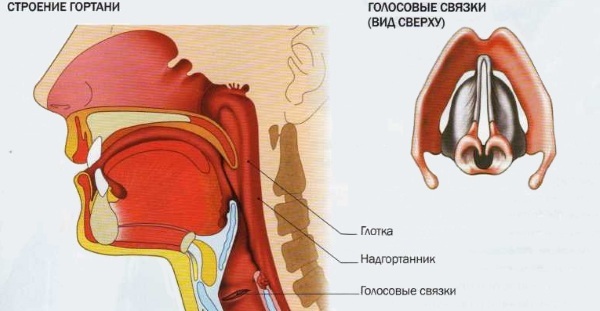
The nasal canals are separated by a septum of cartilaginous tissue, which is characterized by increased elasticity, but at the same time is highly susceptible to deformational changes. For example, in the event of injury.
Functions
The nasopharynx, the structure (sectional photo shows the anatomical structure of this organ) which indicates its smooth transition into the pharynx, performs several important functions that ensure the stable operation of everything organism. The table below details the purpose of this upper respiratory tract.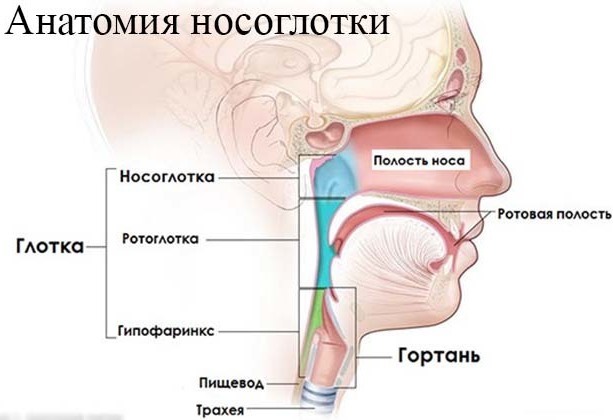
| Function name | Description of the functional purpose of the nasopharynx |
| Respiratory | The nasopharynx is the organ through which a person carries out nasal breathing. The flow of air entering the nasal canals is transported further into the pharynx, fills the trachea, and only then ends up in the bronchial tree. Good ventilation of the nasopharyngeal canals ensures the stable operation of the entire respiratory system of a person. |
| Protective | The tonsils, which are an accumulation of lymphoid tissue, perform an important function of protecting the body from the pathogenic microflora of the environment. Along with the stream of air that is inhaled through the nasal passages, a large number of viruses, bacteria and fungal spores enter. Most of the pathogenic microorganisms are retained by the lymphoid tissue of the tonsils, which removes the immune load, prevents the development of inflammatory and infectious processes in the lower respiratory systems. |
| Warming the air | In the cold season, the flow of air from the environment into the nasopharynx is warmed up in its cavity before being delivered to the bronchi. The implementation of this function allows you to prevent the occurrence of inflammatory diseases of the bronchopulmonary tissue, which can develop after contact with too cold air. |
 Most people do not feel the importance of the nasopharynx until the moment when they are faced with this or that organ disease. The presence of a pathological process in this part of the body disrupts the stable operation of the entire respiratory system, causes discomfort, and becomes the cause of the development of concomitant diseases.
Most people do not feel the importance of the nasopharynx until the moment when they are faced with this or that organ disease. The presence of a pathological process in this part of the body disrupts the stable operation of the entire respiratory system, causes discomfort, and becomes the cause of the development of concomitant diseases.
Communication with nearby authorities
The nasopharynx, the structure (a cross-sectional photo shows all the structural elements of this part of the respiratory system) which is quite simple, associated with the following nearby organs:
- the oral cavity (this organ is separated from the nasopharynx only by a septum in the form of tissues of the hard palate);
- pharynx, which is actually a physiological continuation of the nasopharynx;
- maxillary sinuses (structural cavities in the facial bones of the skull that are designed to warm cold air from the environment, providing a louder voice during playback speech);
- inner ear connected by the eustachian tube.
The presence of pathologies of the tissues of the pharynx, inner ear or nasopharynx is reflected in the functional state upper respiratory tract, provokes the development of inflammatory processes in the inner ear, maxillary sinuses.
What diseases can occur in the nasopharynx?
The tissues of the nasopharynx are susceptible to infectious, inflammatory and oncological processes. Pathological changes in the structure of this organ are caused by the negative impact of external and internal factors.
Squamous cell carcinoma
Squamous cell carcinoma is a cancer that most commonly affects the tissues of the nasopharynx. This is a dangerous pathology, the development of which is accompanied by the growth of the tumor process.
The presence of squamous cell carcinoma can be recognized by the following symptoms:
- bloody discharge from the nasal cavity, which appears spontaneously without physical exertion or mechanical impact on the nasal passages;
- painful sensations in the ears;
- swelling and redness of facial tissues;
- severe dryness of the mucous membrane of the nasal canals and the inner walls of the nasopharynx;
- complete or partial hearing loss (the presence of this symptom indicates that the oncological process is on later stages of their development, and cancer cells have penetrated into the tissues of the Eustachian tube and the structural elements of the internal ear);
- numbness of the part of the face located in close proximity to the nose.
The main danger of squamous cell carcinoma of the nasopharynx is that this disease is characterized by slow and latent development. The above symptoms appear in the later stages of the pathology, when cancer cells have already spread to the tissues of neighboring organs.
This significantly complicates the treatment process, and also worsens the prognosis for recovery. Therapy of squamous cell carcinoma of the tissues of the nasopharynx is carried out with the help of chemistry preparations, radiation. In rare cases, a surgical method is used.
Inflammation of the walls of the nasopharynx
Inflammation of the tissues of the nasopharynx is one of the most common diseases of this part of the body. The painful condition of this organ of the upper respiratory tract develops due to its infection with bacterial or viral microorganisms. In rare cases, the inflammatory process starts after prolonged hypothermia of the body.
The disease is characterized by the following symptoms:
- redness of the nasal mucosa;
- nasal congestion;
- profuse discharge of mucus from the nasal passages;
- characteristic crackling in the ears, which is heard by the patient at the time of swallowing;
- swelling of the nasopharynx, which can spread to facial tissues located in the area of \ u200b \ u200bthe wings of the nose.
Treatment of the painful condition of the nasopharynx is carried out with the help of anti-inflammatory, antibacterial, antiviral drugs. The lack of a therapeutic process leads to the development of chronic inflammation with pathological proliferation of lymphoid tissue, the formation of adenoids.
Polyposis
Polyposis of tissues is not a dangerous disease of the nasopharynx, which occurs as a complication of an existing disease. For example, chronic inflammation of the mucous membrane, an allergic reaction to external stimuli, disorders of the immune system.
Polyps are benign neoplasms that form on the basis of hypertrophied lymphoid tissue. Patients with nasopharyngeal polyposis complain of breathing problems that are completely absent or difficult due to blockage of the nasal passages.
Such patients have a stuffy nose almost all the time, the sound of the voice is nasal and muffled. To completely get rid of nasopharyngeal polyposis, the method of surgical removal of extraneous neoplasms is used. Conservative therapy in the form of drugs can only give a temporary effect in the form of vasodilation of the upper respiratory tract, but does not eliminate the cause of the pathology.
The operation to remove polyps is considered not difficult, and its average duration is no more than 15 minutes. This method of therapy is performed by an otolaryngologist surgeon. The patient leaves the walls of the inpatient department 3-4 hours after the completion of the surgery.
Atrophic rhinitis
Nasopharynx, structure (sectional photo shows the location of the structural elements of this organ) which consists of epithelial, lymphoid and cartilaginous tissues, is susceptible to damage by atrophic rhinitis.
This disease is characterized by the presence of a persistent rhinitis, which leads to pathological thinning of the mucous membrane of the nasal canals, the appearance of signs of sclerotic changes in the tissues nasopharynx. The severe stage of this pathology is accompanied by impaired sensitivity of the peripheral nerves.
Depending on the etiology of the disease, primary and secondary rhinitis of the atrophic type are classified. Elderly people are at risk for this nasopharyngeal pathology. According to medical statistics, most cases of atrophic rhinitis occur against the background of an inflammatory process of a bacterial origin. The tactics of treating this disease depends on the reasons that provoked it.
Signs of defeat
The painful condition of the tissues of the nasopharynx can be recognized by the presence of the following symptoms, which are determined by the results of visual and instrumental diagnostics:
- redness of the mucous membrane that covers the walls of this organ of the respiratory system;
- swelling of the epithelial tissues of the nasopharynx;
- constant or periodic nasal congestion, accompanied by the release of mucous contents from the cavity of its channels;
- painful sensations inside the nasopharynx during blowing your nose, sharp inhalation of air;
- nosebleeds that occur suddenly, or under the influence of certain factors (physical activity, an attempt to blow your nose);
- the presence of extraneous neoplasms in the structure of the epithelial tissues of the nasopharynx;
- hypertrophic proliferation of the lymphoid tissue of the tonsils, which arose due to the pathological degeneration of their cells, or under the influence of chronic inflammation.

There are a large number of diseases that can cause the development of the above symptoms. Determination of the causes of the pathological condition of the nasopharynx makes it possible to start timely treatment, which will restore the functions of this organ of the upper respiratory tract.
How the nasopharynx is examined, diagnostic techniques
Diagnostics of the nasopharynx is performed by an otolaryngologist, infectious disease specialist or therapist. In children, a pediatrician examines this organ of the respiratory system. The table below lists the main diagnostic techniques that are used by specialists to examine the tissues of the nasopharynx.
| Diagnostic method | Survey principle |
| Visual inspection | Visual inspection is the simplest method for examining the functional state of the tissues of the nasopharynx. This procedure takes place in the otolaryngologist's office at the stage of initial admission. The patient sits down in a chair, and the doctor conducts a visual examination of his nasal canals, assesses the condition of the mucous membrane of the back wall of the throat, tissues of the pharyngeal tonsils. If signs of pathology are found at this stage of the examination, the otolaryngologist prescribes additional diagnostic methods for the patient. |
| Endoscopy | Endoscopy is considered one of the most informative examination methods. This diagnostic method enables the otolaryngologist to study the condition of the tissues of the nasopharynx in real time. The principle of this procedure is that a special probe equipped with a digital video camera is inserted into the nasopharyngeal cavity. The resulting image is transmitted to a computer monitor, with the help of which the doctor can detect the foci of the pathological process. |
| X-ray | Radiography is prescribed to diagnose patients with signs of tumor neoplasms in the structure of the upper respiratory tract. This method allows you to detect benign and malignant tumors, regardless of their type and location in the tissues of the nasopharynx. The maximum information content of the diagnosis is achieved if X-ray is used simultaneously with the endoscopic research method. |
| Mucus smears | The selection of smears from the surface of the mucous membrane of the walls of the nasopharynx is necessary to isolate a strain of infectious microorganisms that provoke the inflammatory process. For example, if, after a visual examination of the patient's nasopharynx, the presence of redness was found epithelial tissues, their pronounced swelling, and the patient has signs of an increase in temperature body. |
If the above diagnostic methods are not enough, the attending otolaryngologist decides whether to use CT or MRI studies. All of the above examination methods can be used in combination.
The nasopharynx is an organ of the upper respiratory tract of a person, the structure of which includes 2 nasal canals, lingual, paired tubal, pharyngeal tonsils. The functional purpose of this part of the body is the implementation of nasal breathing, delivery of air to the larynx cavity, and its warming in the cold season.
The walls of the nasopharynx are expelled by a layer of epithelial tissues, which are additionally closed by a mucous membrane. Tonsils act as a lymphoid filter that traps viral, bacterial and fungal microorganisms that enter the nasopharynx along with the air stream. A detailed study of the anatomical structure of this organ of the respiratory system can be done using its photo in section.
Video about the structure of the nasopharynx
Pharynx Anatomy:



